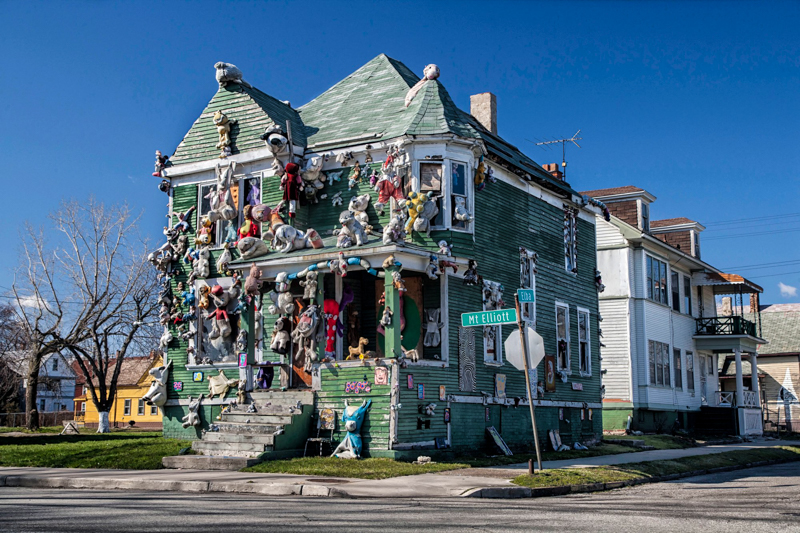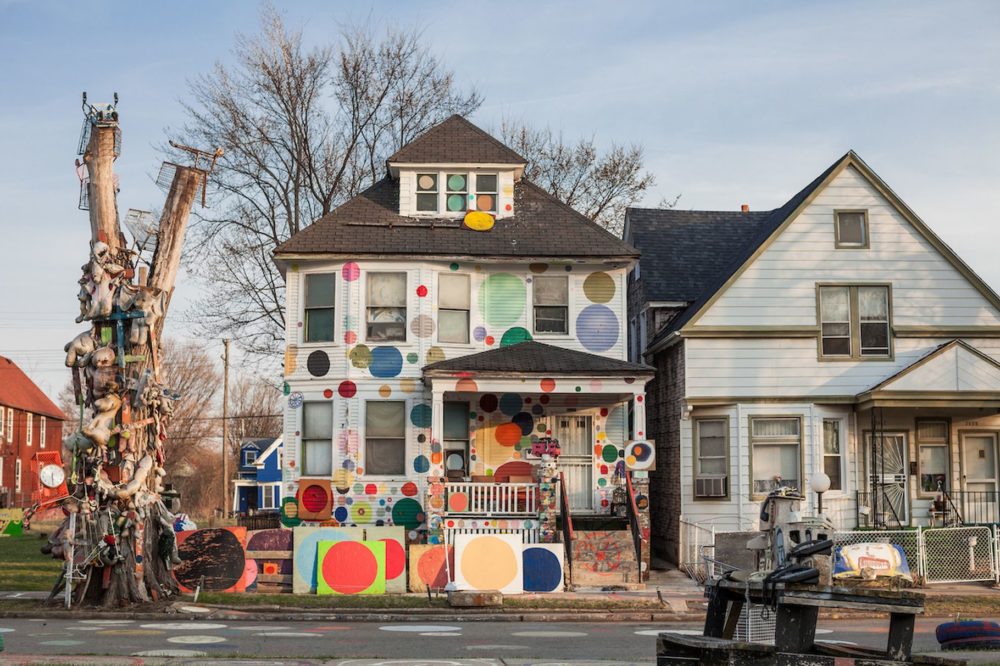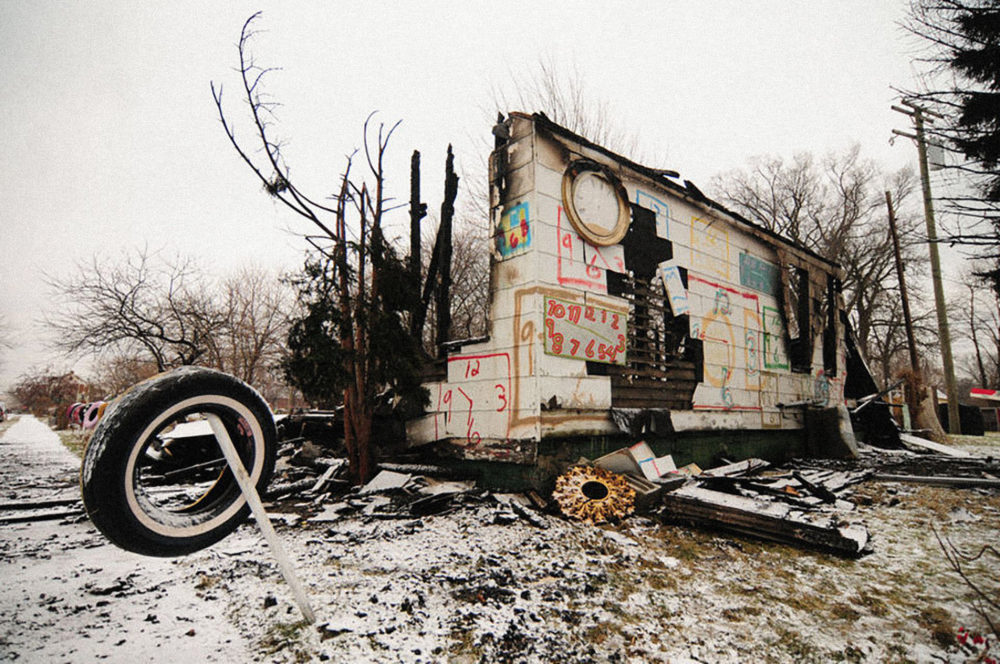In the 1950s and early 60s, when artist Tyree Guyton was growing up, Detroit was an economic success story and a thriving city. But it was also rife with racism, inequality and prejudice. The African-American population was systematically discriminated against through substandard housing, poor education, and low paid work. Racial profiling and police brutality were commonplace; the middle-class white population fled to the suburbs as the world-famous motor industry shed jobs; in the mid 60s, the situation was at boiling point.
In 1967, the police raided a bar on 12th Street and began one of the most violent and destructive uprisings in US history. Forty-six people were killed, thousands were left homeless or injured, a huge number of properties were destroyed.
Tyree Guyton was twelve when the rebellion took place, old enough to understand what was happening, too young to get involved. He had grown up in the relatively affluent, diverse working class, suburban neighbourhood of McDougall-Hunt on Detroit’s East Side which, along with many others of its kind, had suffered in recent years from lack of investment and grinding poverty. When Guyton returned to the area as a young adult after serving in the army, things had deteriorated beyond recognition. In his words, it looked as if “a bomb had gone off”.1 Houses were boarded up, drug use was endemic, people were afraid to walk the streets day or night, the soul of the place had disappeared. Three of his brothers had become homeless; his family was in despair.

In an attempt to reclaim the area, Guyton, along with his wife Karen Guyton and grandfather Sam Mackey, established the Heidelberg Project in 1986 (Heidelberg is the street he grew up on). What was later called an outdoor art environment, the initiative introduced the idea of the ‘found object’ to the neighbourhood and to the broader community arts infrastructure. The three of them worked with local residents (including many children) to clean out derelict buildings and plots of land. Vacant lots literally became ‘lots of art’ and abandoned houses became ‘gigantic art sculptures’. They all had themes and were given names, amongst them: The Baby Dollhouse, House of Soul, Faces in the Hood, Party Animal House.
Sculptures made from reclaimed junk were incorporated into front yards and building facades on Heidelberg Street. Buildings were painted a riotous set of colours and patterns, and soon the project expanded into other streets, trees, abandoned cars, and sidewalks. The outcome was both a display of irreverence and collective creativity, reflecting Guyton’s interest in art practice as both playful and deadly serious.

This collaborative, evolving endeavour became hugely contentious, with a vociferous group of local people expressing a fierce disdain for the project, which, in their eyes, contributed to, rather than detracted from, the surrounding urban blight. They were often on the same page as Detroit council members: “This is not done here. You take that to New York or Chicago.”2
The goal was to develop the Heidelberg Project into the city’s first outdoor museum, complete with an artists’ colony, creative art centre, community garden and amphitheatre. The project began to make ripples beyond the neighbourhood, into other parts of Detroit and beyond, receiving national media attention and multiple awards.
When Detroit Mayor Coleman Young ordered the demolition of a number of the Heidelberg houses in 1991 and 1999, it didn’t stop the project from expanding, eventually occupying the entire block. In 2008, the Heidelberg Project represented the United States in the Venice Architecture Biennale.
Some of the houses assume an overtly political identity, referencing the often fraught relation of the programme to the city of Detroit. The Obstruction of Justice (O.J.) House came about when a family moved out in 1994 and gave Guyton the keys saying “Turn it into a work of art”. The name refers to the city’s demolition order of 1991 which Guyton saw as an ‘obstruction of justice’, as well as the hugely contentious trial of O.J. Simpson.

In 2013, part of the project – including the O.J. House – was burned to the ground in a suspected arson attack. It was soon followed by a further fire which destroyed another house. By the end of the year, eight fires had burned down five houses. In 2014, a sixth house was burned to the ground. The rationale for the attacks is not clear.
By 2016, Guyton made a statement that he was profoundly saddened by the destruction of the houses and that he planned to dismantle what had become an iconic art installation enjoyed by thousands of people. He was sixty years old; he’d spent half his life working on the project.
However, the artist gained a second wind and relaunched the project under the name Heidelberg 3.0. The Wayne County Circuit Court ruled that it was to be protected under the 1st Amendment. Guyton and his team of supporters negotiated with the Detroit Land Bank, garnered 2,500 signatures of support, and purchased its first headquarters in the community featuring a 7,000 square foot building, a residence, and six adjacent lots.
In 2019 the Museum of Contemporary Arts Detroit staged an exhibition of a selection of deconstructed works from the Heidelberg Project, and the Heidelberg Arts and Leadership Academy was launched in Detroit schools. Today, the project is visited by 200,000 people a year.
As art historian Gill Perry has written, destruction has been incorporated into the Heidelberg project in order to create a performative form of ongoing resistance and rebuilding. In its thirty-four year history, the site has become both a hugely successful community arts venture as well as a political protest, harnessing the transformative and disruptive potential of destruction.
